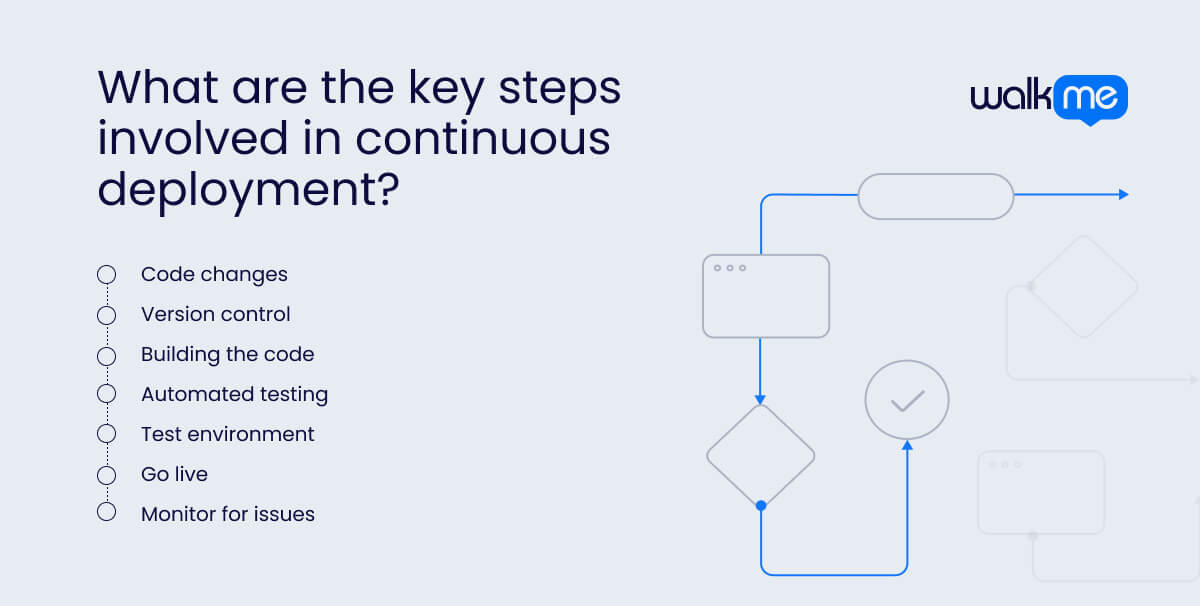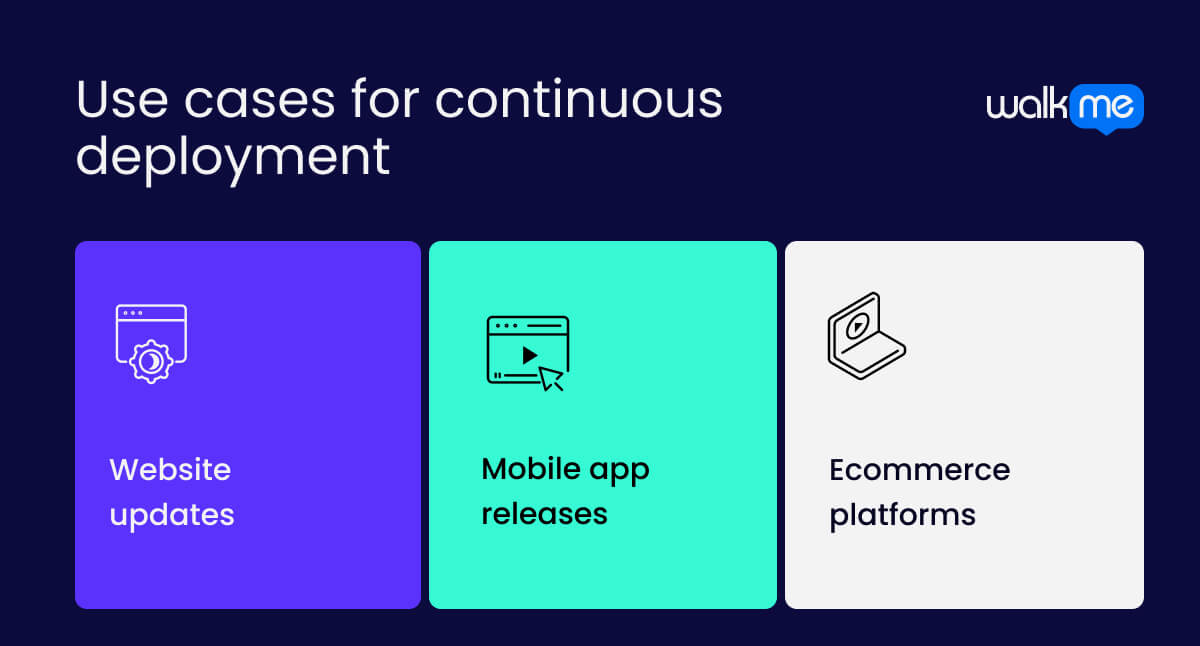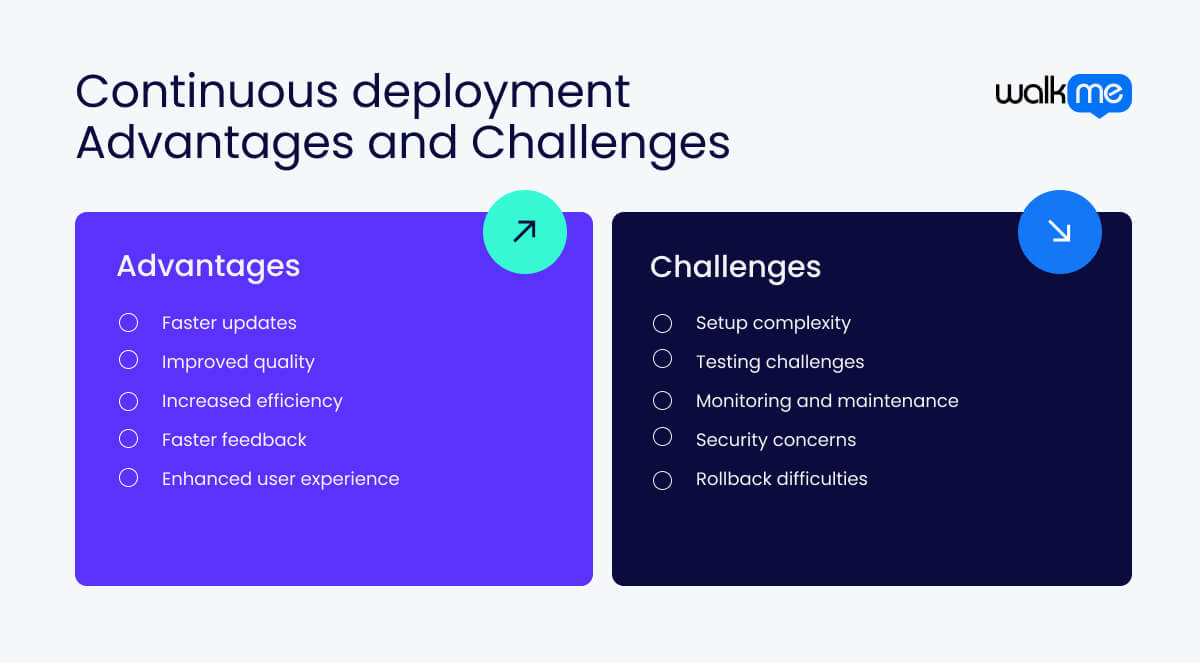What is continuous deployment?
Continuous deployment (CD) is a software development practice where code changes are automatically built, tested, and deployed to production environments without manual intervention. Once code passes automated tests in the continuous integration pipeline, it is automatically released to end-users.

Table of contents
- What is continuous deployment?
- What are the key steps involved in continuous deployment?
- Continuous deployment vs continuous delivery
- Use cases for continuous deployment
- What are the advantages of continuous deployment?
- What are the challenges of continuous deployment?
- How can DAPs help with continuous deployment?
As a result, new features, updates, or fixes reach users quickly without waiting for manual approval, making the process faster and easier for developers.
A big advantage of continuous deployment is that updates are delivered to users as soon as they are ready. Developers can fix problems or add new features without delay. Automated tests also ensure the changes are safe, so fewer mistakes happen when the updates go live.
Continuous deployment also helps developers work together better. Because changes happen often, they need to write good, clean code that is ready to be used. The method allows developers to improve the software step by step, making it consistently better.
Continuous deployment allows companies to deliver new features and implementations into applications more quickly. It has radically changed how businesses release and upgrade digital products.
Its popularity as a DevOps method is reflected in the fact that 47% of developers use continuous integration or deployment.
What are the key steps involved in continuous deployment?

Understanding the steps in continuous deployment helps ensure smooth updates. Each step is important for creating new changes, testing them, and sending them to users automatically, ensuring the software works well.
From writing code to testing and sending it live, each part helps keep the software updated without the need to do it manually.
Let’s examine the main steps in continuous deployment and see how they all work together to facilitate updates.
Code changes
Developers write code to develop new features or fix issues in the software. Once they are happy with the changes, they save them in a shared system. Others are able to see what was changed and use the updated code. It helps everyone stay organized and know exactly what’s been added or fixed.
Version control
The code is stored in a system that tracks every change made by the developers. This is important because it keeps a record of all the updates, so nothing is lost. If something goes wrong, the developers can go back to an earlier version of the code. It helps teams work together smoothly without worrying about losing progress.
Building the code
After the code is saved, it needs to be assembled, or “built,” by a computer program. Using an automated process ensures that all the pieces of code fit together correctly. If there’s a problem during the build, it gets caught early, and the developers can fix it before moving forward. The step ensures that the code is ready to be tested and eventually used by real people.
Automated testing
Once the code is built, it undergoes several automated tests. These tests check if the code works as intended. For example, small tests ensure that individual parts work and bigger tests check if the new code works well with the rest of the software. These tests are run by computers, and they quickly catch problems before the code is released.
Test environment
After passing the automated tests, the code is moved to a test environment. The space lets the software be tested as if it’s being used in real life. It helps find any problems that might only show up when people start using the software. By building in an extra testing step, workers ensure that everything will work smoothly when the code is finally released.
Go live
When all the tests are passed, the code is automatically sent to the live system. Real users can now use the new features or updates. This happens without needing manual work, so updates can be delivered quickly and efficiently.
Monitor for issues
After the code is live, the system is carefully monitored for issues. Unexpected problems can be caught early, allowing developers to fix them quickly. Feedback from such monitoring can help improve future updates.
Continuous deployment vs continuous delivery
Continuous deployment and continuous delivery both help with updating software, but they do it in different ways.
- Continuous deployment automatically sends new updates to users as soon as they pass tests, without needing anyone to approve it.
- Continuous delivery also gets updates ready, but someone must check and approve them before they go live.
Let’s look at how they differ.
| Continuous deployment | Continuous delivery | |
| Definition | New code is automatically sent to users after passing tests. No one needs to check or approve it before it goes live. | New code is ready to go live after passing tests, but someone must approve it before it is sent to users. |
| Focus | Fully automating everything, so new updates go live without any human checks. | Automating most of the process, but humans still decide when the code goes live. |
| Techniques | Lots of automated tests are run to make sure the new code works well before it goes live automatically. These tests check small parts and how everything works together. | Automated tests are used too, but the code is not sent live until someone approves it. The team decides when it’s ready for users. |
| Goals | Provide users with updates as soon as they pass tests. This helps keep things moving quickly and smoothly. | Always have updates ready to go, but to release them when it’s the right time. There is more control over when updates are sent. |
| Examples of use | Companies like Facebook and Netflix use continuous deployment to send updates to users quickly, providing new features and fixes right away. | Banks and healthcare services use continuous delivery because they need more control over when updates go live to ensure extra safety. |
Use cases for continuous deployment

Continuous deployment is useful in many business situations. It helps keep websites up-to-date, ensures mobile apps have the latest features, and quickly updates online stores.
Here are three examples of different uses of continuous deployment to help you understand how it works in real life.
Website updates
Continuous deployment keeps websites current with the latest features and fixes. When developers make changes, these updates are automatically tested to ensure they work. After testing, the updates are automatically published, so users always see the newest version of the site. Problems can be fixed quickly, and the site stays up-to-date without needing extra checks.
Mobile app releases
For mobile apps, continuous deployment ensures users get new features and fixes right away. When developers update the app, it undergoes automatic tests to check for errors. Once tested, the updates are sent to users’ devices automatically. Not only is the app kept current, but continuous deployment improves the user experience so that people always have the latest version without waiting for manual updates.
Ecommerce platforms
For online stores, continuous deployment helps add new features quickly. Things like new payment options or updated product lists are tested and deployed automatically. In other words, the store can offer new improvements fast and keep the shopping experience fresh. Customers always have access to the latest features, making their shopping experience better and more enjoyable.

What are the advantages of continuous deployment?
Continuous deployment has many benefits for businesses. It helps companies quickly deliver updates, fix problems, and keep software running smoothly, improving the software and keeping users happier. Let’s take a closer look at all the advantages of continuous deployment.
Faster updates
Continuous deployment automatically sends new updates to users as soon as they are ready. Whenever developers make changes or fixes, these are quickly delivered to users. Users don’t have to wait for a long time to get the latest features or fixes, so the software stays up-to-date, and they have a better experience.
Improved quality
Automated testing checks the new code for problems before it goes live. Any issues are caught and fixed early, so users don’t see bugs or errors. By making sure only good code is released, the software works better and is more reliable, leading to happier users.
Increased efficiency
With continuous deployment, updates are managed automatically, saving time and effort. Developers don’t need to handle each release manually, so they can focus on improving the software. The whole development process becomes faster, letting teams get more work done.
Faster feedback
Users see new features or fixes right away, and their feedback helps developers make quick improvements. Such fast feedback helps developers fix problems and improve the software based on users’ needs.
Enhanced user experience
Regular updates and quick fixes improve users’ interactions with the software. They get new features and improvements without long waits, keeping the software enjoyable and up-to-date and making users more satisfied.
What are the challenges of continuous deployment?
Now, let’s look at the challenges of continuous deployment. While it helps businesses quickly send updates and improve software, it also has some difficulties. Knowing these challenges is important to handling them well and keeping everything running smoothly.
Setup complexity
Setting up continuous deployment can be tricky. It involves connecting different tools and systems to automate updates. Such a setup takes time and effort, and companies might need special skills or help to get it working properly.
Testing challenges
Continuous deployment depends on automated tests to check if the new code is ready. Creating and keeping these tests accurate can be hard. They need to cover many scenarios and be updated as the software changes, which takes time and effort.
Monitoring and maintenance
After setting up continuous deployment, regular checks and maintenance are needed. Workers need to watch for any problems or errors and fix them quickly. Ongoing attention ensures updates go smoothly and don’t cause unexpected issues, but it is time-consuming.
Security concerns
Automated deployments can sometimes create security risks if not managed carefully. New updates might introduce vulnerabilities if proper security checks aren’t performed. To keep the software safe, it’s important to ensure security is part of the deployment process.
Rollback difficulties
If a new update causes problems, returning to the previous version can be hard. Continuous deployment systems need a good plan for quickly undoing changes without causing issues. Managing rollbacks efficiently requires careful planning and good tools.
How can DAPs help with continuous deployment?
Digital adoption platforms (DAPs) can make continuous deployment easier to handle. When businesses use a DAP, they get tools that help manage and roll out software updates smoothly. These platforms guide users through new features and changes, making it simpler for everyone to adjust.
Let’s see how DAPs help with continuous deployment and improve the update process.
User training and guidance
People are taught how to use new features directly within the interface. The platform offers easy-to-follow guides and tips which are easy to access. Processes become simple for users to understand, and they can use the latest updates without getting confused.
Change management
The software supports change management by providing help and instructions when new updates are released. It explains new features and changes so users can adapt quickly and easily, resulting in much smoother transitions to new updates.
User feedback
DAPs collect feedback from users about new updates. This helps developers determine whether the changes are working well or if there are problems. Gathering feedback helps improve the software and ensure that updates meet user needs.